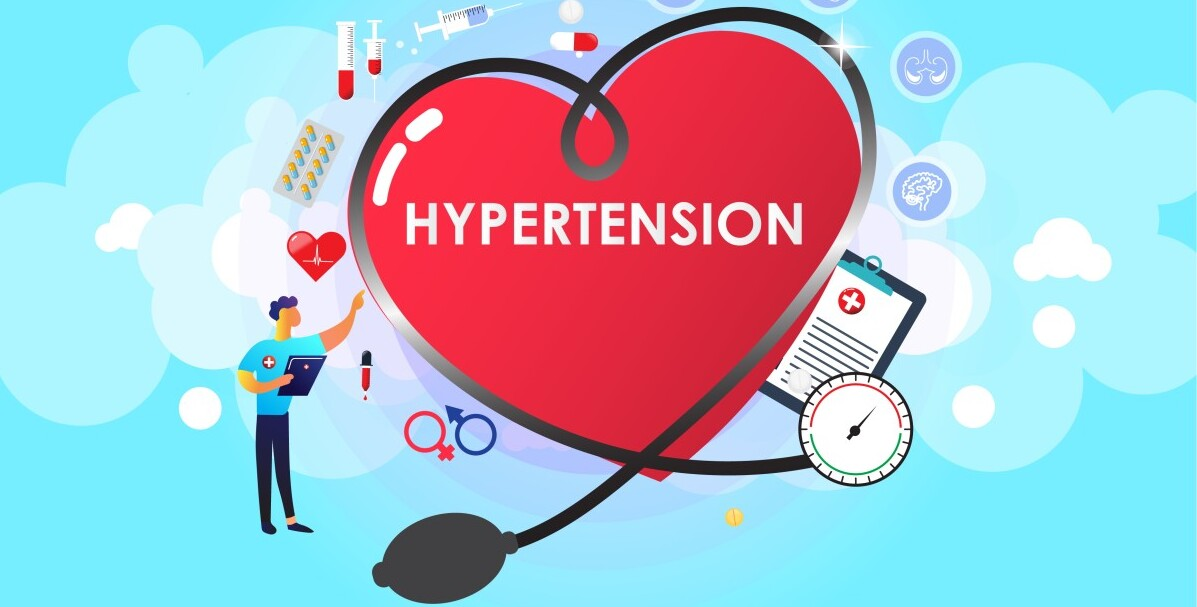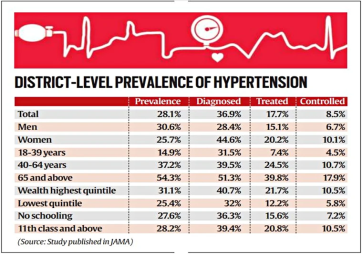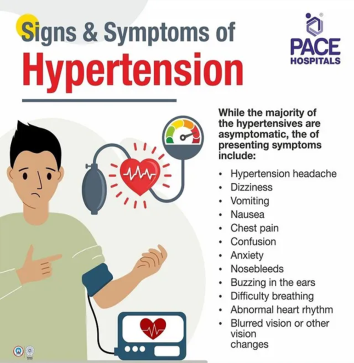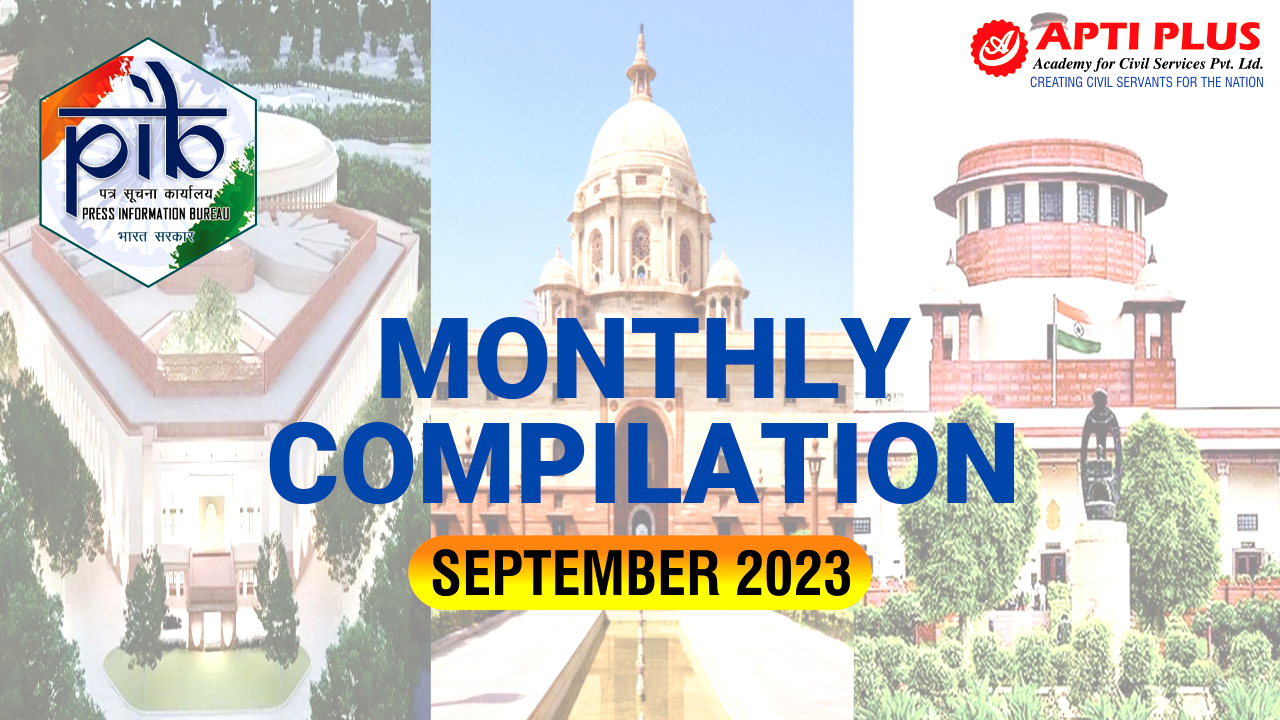Description

Copyright infringement not intended
Picture Courtesy: www.apollohospitals.com
Context: Addressing regional disparities in hypertension and its treatment across India is vital for maintaining overall public health and well-being.
Details
- A recent study reveals a diverse landscape in the prevalence, diagnosis, treatment, and control of hypertension across Indian states. This indicates that a one-size-fits-all approach might not be effective in addressing the issue.
- The analysis highlighted disparities not only in prevalence but also in the diagnosis, treatment, and control of hypertension. This suggests that healthcare interventions should be tailored to specific regions and communities to bridge these gaps effectively.
- The researchers advocate for "targeted, decentralized solutions" to tackle hypertension. This means tailoring interventions to specific regions and districts based on their unique challenges and needs.
.jpg)
Key Highlights of the Report
National-Level Disparities
- The study indicates a substantial gap in the continuum of care for hypertension in India.
- Only 33% of individuals with hypertension receive a formal diagnosis, which implies that a significant portion of the population may be unaware of their condition.
- Among those diagnosed, only 20% initiate treatment, highlighting a low rate of adherence to medical recommendations.
- Further, only 8% of individuals with hypertension achieve blood pressure control, emphasizing the challenges in managing this condition effectively at a national level.
Inter-State and Inter-District Variability
- The prevalence of hypertension in southern states is higher than the national average, suggesting a regional variation.
- Within states, there are significant differences at the district level, indicating that the burden of hypertension is not evenly distributed.

Impact of Demographics
- The study explores how age, gender, socioeconomic conditions, and education influence hypertension care.
- Despite men being more likely to have hypertension, women are more likely to be diagnosed, treated, and have their blood pressure under control, challenging conventional assumptions.
- Individuals over the age of 65 exhibit higher levels of prevalence, diagnosis, treatment, and control, suggesting a focus on the elderly in hypertension management.
- Socioeconomic factors play a role, with the wealthiest fifth of the population showing the highest levels of prevalence, diagnosis, treatment, and control, indicating disparities in healthcare access.
District-Level Data for Planning
- The district-level breakdown of data provides actionable insights for state governments.
- Regional variations necessitate tailored strategies; for example, areas with lower diagnosis rates may need increased screening efforts.
- Issues such as irregular availability of medicines can be addressed by ensuring a consistent supply chain.
- The proximity of healthcare centres and the need for digitization of records for effective follow-ups become crucial considerations.
Challenges in Hypertension Care
- Unlike acute diseases where patients actively seek care, hypertension management requires continuous attention.
- The irregular availability of medicines can lead to gaps in treatment, necessitating a focus on consistent accessibility.
- The study emphasizes that addressing hypertension goes beyond screening and diagnosis; a holistic approach to the continuum of care is essential.
WHO Report and Government Initiative
- The WHO report highlights the potential to prevent 4.6 million deaths in India by 2040 through improved blood pressure control.
- The government's initiative to treat 75 million people with hypertension or diabetes by 2025 is a positive step toward addressing the growing burden of chronic diseases.
- However, the study suggests that controlling hypertension requires more than just increasing infrastructure; it involves active screening, timely treatment, medicine accessibility, and regular follow-ups to ensure sustained control.
Hypertension
- Hypertension, or high blood pressure, is also known as the "silent killer" because it often has no symptoms but can cause serious damage to the blood vessels and organs over time. If left untreated, hypertension can lead to heart attack, stroke, kidney disease, vision loss, and sexual dysfunction.
What is hypertension and how is it measured?
- Blood pressure is the force of blood pushing against the walls of the arteries, which carry blood from the heart to the rest of the body. Blood pressure is measured in millimetres of mercury (mm Hg) and divided into two numbers: systolic and diastolic.
- Systolic pressure is the pressure when the heart contracts and pumps blood out to the body.
- Diastolic pressure is the pressure when the heart relaxes between beats.
- Normal blood pressure is below 120/80 mm Hg. Hypertension is defined as a systolic pressure of 130 mm Hg or higher or a diastolic pressure of 80 mm Hg or higher. The higher these numbers are, the more strain is put on the heart and blood vessels, and the higher the risk of complications.

What causes hypertension and who is at risk?
- Blood pressure tends to rise with age, especially after 50 years.
- Having a close relative with hypertension increases risk of developing it.
- African Americans are more likely to have hypertension than other racial groups.
- Being overweight or obese puts extra pressure on the heart and blood vessels.
- Eating too much salt, saturated fat, cholesterol, and sugar can raise blood pressure.
- Smoking damages the lining of the arteries and makes them narrower and stiffer.
- Drinking too much alcohol can raise blood pressure and damage the liver and kidneys.
- Chronic stress can trigger hormones that constrict blood vessels and increase blood pressure.
- Lack of exercise can make the heart weaker and less efficient at pumping blood.
- Some diseases or disorders can cause or worsen hypertension, such as diabetes, kidney problems, sleep apnea, thyroid or adrenal gland problems, etc.
- Some drugs can raise blood pressure as a side effect, such as birth control pills, steroids, decongestants, etc.
How can hypertension be diagnosed and treated?
- Hypertension can be diagnosed by measuring blood pressure using an instrument called a sphygmomanometer.
- Hypertension cannot be cured with a short-term round of medications or a procedure. It requires lifelong management with medications and lifestyle changes. The goal of treatment is to lower blood pressure to a safe level and prevent complications.

Conclusion
- The study presents a detailed picture of the challenges in hypertension care in India, offering nuanced insights into regional variations, demographic influences, and the need for a comprehensive approach to the continuum of care. The district-level data serves as a valuable guide for policymakers to formulate targeted and effective healthcare interventions.
Must Read Articles:
Status Of Non-Communicable Diseases In India: https://www.iasgyan.in/daily-current-affairs/status-of-non-communicable-diseases-in-india
|
PRACTICE QUESTION
Q. What are the key factors contributing to the rising prevalence of non-communicable diseases in India, and what measures can be taken to address and mitigate this growing health challenge?
|













